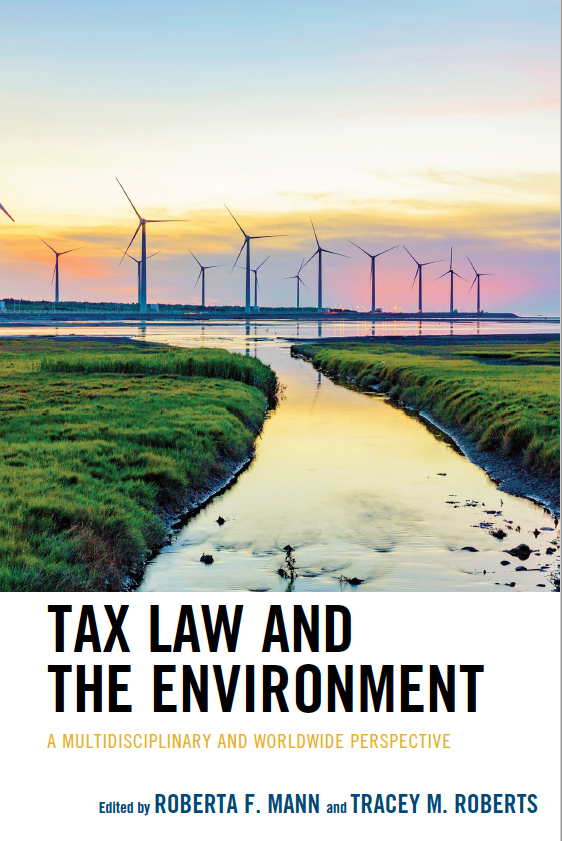Published on July 20, 2020 by Morgan Black

In this interview, Cumberland School of Law associate professor Tracey M. Roberts discusses Tax Law and the Environment: A Multidisciplinary and Worldwide Perspective, for which she was the co-author.
Tax Law and the Environment takes a multidisciplinary approach to explore the ways tax policy is used to solve environmental problems throughout the world. Environmental taxation involves using taxes to impose a cost on environmentally harmful activities or tax subsidies to provide preferred tax treatment to more sustainable alternatives. This book provides a detailed analysis of environmental taxation, with examples from around the world. As the extraction, processing and use of energy resources has been a major cause of environmental harm, this book explores the taxation and subsidization of both fossil fuels and renewable energy. Its analysis of the past, present, and future uses of environmental taxation will help policymakers move economies toward sustainability, as well as inform students, academics, and citizens about tax solutions for pressing environmental issues.
A new paperback version of the book, first released in 2019, is now available on Amazon.
What inspired you to write a book on this topic?
In 2016 on my way to Alabama to join the Samford University faculty, I attended the Law and Society Association conference in New Orleans. At one of the tax-focused sessions, Professor Neil Buchanan announced that Lexington Books was calling for proposals to expand their set of tax publications. I discussed the possibility of writing a book on tax law and the environment with my friend, Roberta Mann, a fellow tax professor at the University of Oregon. In 2010, when I had first entered academia, Roberta introduced me to an international conference, the Global Conference on Environmental Taxation, which occurs every year. The academics that gather at that event are extraordinary and hail from many fields in academia, including law, economics, finance and environmental programs, from global institutions, such as the World Bank, the United Nations, Organization of Economic Cooperation and Development, and from governmental authorities. We thought that we would be able to pull from their expertise and from very well-known scholars in the United States to develop a volume that provides an overview of the tax instruments that governments in different regions of the world are using to address environmental problems and to examine certain global governance issues of concern to all nations.
What is environmental taxation?
Environmental taxation is the use of taxes or subsidies as regulatory tools to address harmful activities that affect the environment, such as pollution, and to encourage the development of environmental goods, such as the habitat of endangered species. The book also discusses subsidies that support fossil fuel extraction, production, and use, all of which increase pollution and exacerbate climate change.
This book provides a detailed analysis of environmental taxation from around the world. What are the major similarities and differences that you found?
Many countries employ taxes on gasoline, diesels fuels and other products and activities that cause pollution. Most developed countries impose taxes on greenhouse gas producing activities or undertake other forms of regulation to address climate change. Unfortunately, the United States is the only developed nation that is not only failing to address climate change, but undertaking policies designed to exacerbate it. Right now, the current administration is actively working to roll back over 100 environmental rules. Among those, a dozen regulations have been reversed that affect the coal, oil and gas industries. In addition, recent changes to federal income tax rules have provided enormous tax refunds to the oil and gas industry. Together all of these actions reverse our progress on climate change.
In what ways does this book explore the taxation and subsidization of both fossil fuels and renewable energy?;
From the early history of the United States, Congress has used subsidies to promote national security, to engage in economic development and to reduce the risk of transporting remote natural resources to markets. State and federal subsidies have supported the harvesting of timber, and the exploration, extraction, processing, and transport of coal, oil and natural gas. Now, however, our reasons for subsidizing these industries no longer exist. The risks and costs associated with exploration and extraction activities have declined and now we know that the production and use of fossil fuels have serious, long-term costs and may lead to potentially catastrophic consequences. Nevertheless, most of the tax subsidies for fossil fuels remain in place after 100 years. In recent years, Congress has added a few temporary tax credits to support the development of renewable energy. The tax credits have been beneficial, but their temporary nature and other recent changes in the U.S. tax code have made them less effective at attracting capital to renewable energy development.
What are a few common misconceptions about this area of law?
I think that most people think that taxes are bad or harmful. However, taxes can be the best tools for protecting people. For example, many human and industrial activities emit pollutants that harm others. We know that air pollution has caused asthma attacks, lung disease, and excess deaths. The traditional methods for controlling pollution may be expensive. They could cause companies to go out of business and lead to unemployment. However, if we impose a tax on pollution to the extent of the harm from that pollution, we can both save lives and businesses. If set at the right level, the tax will minimize the harmful effects of pollution, and businesses will be able to make the best, most cost-effective decisions about how to reduce pollution. In addition, pollution tax revenues can be used to help businesses transition to non-polluting technologies and cover the medical expenses of those harmed by pollution. Tax can be an ideal instrument for managing competing concerns. For example, a carbon tax would address climate change, allow businesses to make sound and efficient decisions about their energy sources, goods and services, and provide funding to households to help them manage higher energy costs.
What are some of the key things that you would like readers to take away from your book? First, I would like to highlight some of the marvelous work of the authors. Janet Milne, who wrote the introduction, is really one of the most well-known and respected scholars in environmental taxation in the United States. She does a beautiful job of introducing our readers to key concepts. George Yin, who served as chief of staff of the Joint Committee on Taxation and as tax counsel to the Senate Finance Committee during the tax reform efforts of the 1980s, now teaches at the University of Virginia. He gives us insight into the possibly erroneous thought processes behind some of the most lucrative tax giveaways to the oil and gas industries. Michael Graetz, who served as the assistant to the secretary and special counsel for the Department of the Treasury in the 1990s, and teaches at Columbia and Yale, has written widely in the field of taxation. For our book he has reprised some of his research from his 2011 book, The End of Energy, to include recent developments in the United States and clarification of the role of renewable energy. University of Oregon professor Roberta Mann, my co-author, shines a light on the many hidden tax subsidies to the coal industry. Economist Terry Dinan, senior advisor with the Congressional Budget Office, examines the economic impacts of a carbon tax and discusses the many ways governments may mitigate the effects on low-income households. Professor Nancy McLaughlin, with the University of Utah, brings her unparalleled expertise to bear on conservation easements, providing new insights and clarifying lessons learned from the American experience.
Perhaps the key contribution of the book is that we have gathered a group of renowned international scholars to provide global perspectives on the use of environmental taxation. Aarhus University professor, Mikael Skou Andersen, recounts the history and diffusion of carbon taxes throughout Europe, relating how so many countries with very diverse economic interests, circumstances, and policy goals came to employ carbon taxes in their fiscal and policy frameworks. Takeshi Kawakatsu, Sven Rudolph, and Soocheol Lee do a beautiful job of clarifying the challenges associated with coordinating a low-carbon policies in Japan and East Asia. Professor Rodolfo Salassa Boix, with the National University of Cordoba, Argentina, provides an overview of environmental taxation in Latin America; it is a rare privilege to have this information made available in English. Professor Natalie Stoianoff, with the University of Technology Sydney, gives us a superb history and analysis of the various initiatives that have been developed to protect the environment in Australia and discusses recent efforts to evaluate their effectiveness. Professor Deborah Jarvie, with the University of Lethbridge, gives us a comprehensive overview of the diverse array of taxes and subsidies our neighbor, Canada, and its provinces have developed. Finally, my chapter provides a critical examination of the impact of global trade law and World Trade Organization decisions on the development of renewable energy, contrasting the nominal scrutiny given to vastly greater fossil fuel subsidies and supports.
What differentiates your book from other tax law titles on the market?
The book differs from most tax volumes in focusing exclusively on taxes and subsidies that by design or consequence affect the environment. The book differs from most environmental texts in focusing solely on taxes and subsidies. However, the real contribution is the global perspectives and the authority of the contributing scholars in providing access to the history of our environmental dilemmas and our current tax-based solutions. We anticipate that the book will help policymakers move their economies toward sustainability and provide an excellent resource for students, academics and citizens to learn about tax solutions for our pressing environmental issues.

I am grateful to relate that Tax Law and the Environment: A Multidisciplinary and Worldwide Perspective is now available in both hardback (approximately $115) and paperback (approximately $45) formats from the publisher, Lexington Books, an imprint of Rowman & Littlefield.
Located in the Homewood suburb of Birmingham, Alabama, Samford is a leading Christian university offering undergraduate programs grounded in the liberal arts with an array of nationally recognized graduate and professional schools. Founded in 1841, Samford enrolls 6,324 students from 44 states, Puerto Rico and 16 countries in its 10 academic schools: arts, arts and sciences, business, divinity, education, health professions, law, nursing, pharmacy and public health. Samford is widely recognized as having one of the most beautiful campuses in America, featuring rolling hills, meticulously maintained grounds and Georgian-Colonial architecture. Samford fields 17 athletic teams that compete in the tradition-rich Southern Conference and boasts one of the highest scores in the nation for its 97% Graduation Success Rate among all NCAA Division I schools.
